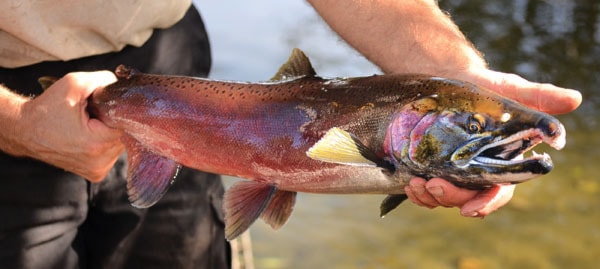There is joy on the rivers.
Salmon are returning to their Shuswap spawning grounds in much better numbers than previously expected.
“The biggest thing locally is the return of the Shuswap early summer (sockeye) stocks,” says federal department of Fisheries and Oceans Canada Interior director Barry Rosenberger, of the early-run sockeye that are counted at a fish fence on Scotch Creek. “They came back quite a bit better than the brood year.”
Some 33,000 early run sockeye were counted this year, up substantially from the 8,000 that spawned four years ago. The early sockeye spawn has also peaked on the Seymour River and while data has not been completed, DFO officials are expecting a similar return to Scotch Creek. While the Adams River sockeye run was just getting underway last Wednesday, Rosenberger says a recent test fishery at the mouth of the Fraser River points to the return of several hundred thousand sockeye.
“This is a pleasant surprise considering the return in the last brood year four years ago,” he says, noting only 50,000 sockeye spawned in the Adams River that year. “Returns are better than we expected, we’re doing quite well in most stocks.”
Rosenberger says the annual migration last year and this has begun later than it has been since the late 1990s.
“They were migrating earlier over the past 10 years, but seem to have reverted back to the more traditional migration,” Rosenberger says. “We did a fair bit of research to find out why they were coming back earlier, and what we did find was higher mortality because they had to spend more time in fresh water before they spawned.”
Rosenberger says migrating salmon had been spending between 40 to 45 days in fresh water for a number of years. This leaves them more susceptible to parviscapsula, a parasite scientists believe could have contributed to increased mortality levels.
“Last year, they didn’t enter the Fraser until mid September and they migrated up and spawned before 30 days, so we had lower mortality,” he says.
Rosenberger says pink salmon numbers are also up, getting into peak spawn right now on the Adams, Shuswap and Salmon rivers.
“We won’t have those numbers till around Christmas,” he says. “But, it was around 150,000 last cycle (two years ago), and we expect the numbers to be about the same this year.”
Rosenberger describes the chinook spawn, which is just coming to a close, as having “really large” numbers as well.
